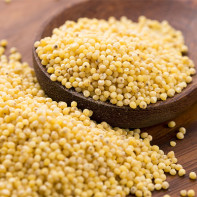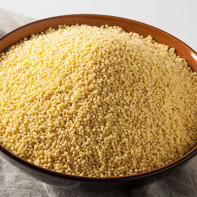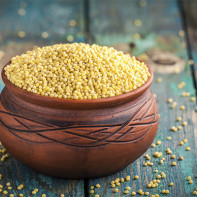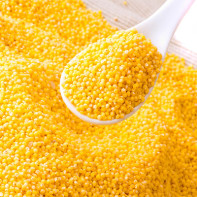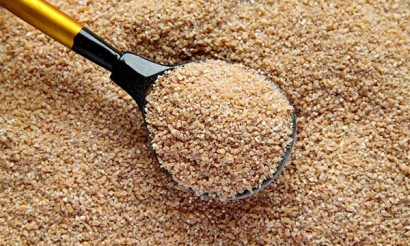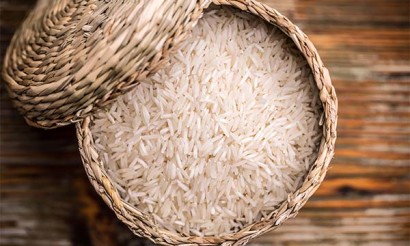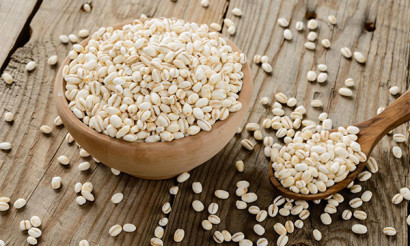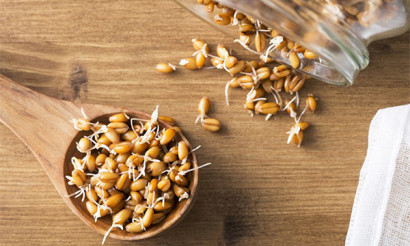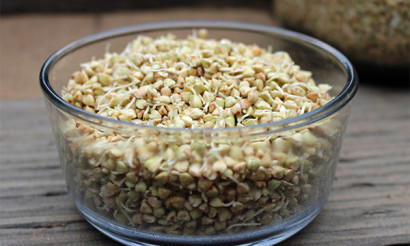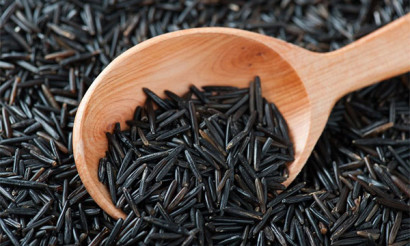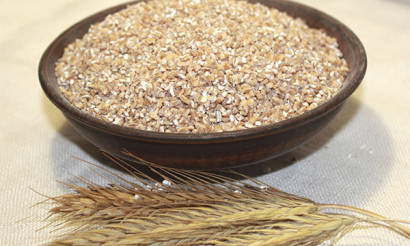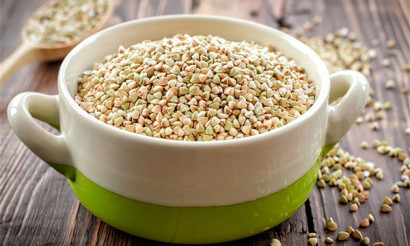What is millet: composition, useful properties, how to cook
Millet is a cereal that many people love and often use in their diet. This porridge is not only tasty, but also very useful. It can be used not only in the menu of a healthy person, but also serve as an auxiliary component of the diet in various diseases. To properly use this product, it is necessary to know its composition, useful properties and caloric value.
- What is millet made of?
- What is the difference between millet and wheat?
- What is healthier: rice or millet
- Composition and calories
- The Usual Properties of Millet
- Millet for Women
- For Men
- Pregnancy
- Breastfeeding
- For children
- When losing weight
- Millet in medicine
- Diabetes mellitus
- For pancreatitis
- For gastritis
- For bowel
- For constipation
- For gout
- For the liver
- For hemorrhoids
- For cholecystitis
- For hypothyroidism.
- For cystitis
- Millet in cosmetology
- Hazards and contraindications
- Can millet be allergic?
- How to choose and store
- How to cook millet: Recipes
- With milk
- With water
- In a multicooker
- How to cook millet in the oven
- Porridge with meat recipe
- Sweet millet porridge
- Can I Give Millet to Animals
- Interesting Facts about Millet
What is millet made of?
Millet is the name of the already prepared cereal, not the very plant from which it is derived. It comes from the processing of the seeds of millet, an annual cereal crop that is grown on an industrial scale for food production. The technology of creation is quite simple:

- Combines are used to harvest when the millet grains are ripe.
- In the second stage, they are sifted to remove small organic debris.
- After that, the seeds are poured into a special threshing machine, where they are cleaned by mechanical impact.
The resulting cereal is packed in bags and sacks or sent on to food factories for the production of finished products. This plant is also used to make flakes, which have a higher cooking speed.
What is the difference between millet and wheat groats
Because of the consonance of the names, millet is often confused with wheatgrass, but they are two completely different products. They have something in common - both species belong to the cereal genus, the bluegrass family. But, in fact, they are two completely different products. Millet is made from the peeled kernels of millet seeds. Wheat groats are ground wheat kernels, which are previously subjected to purification.
The main difference between wheat groats - high starch content, in millet it is less. But the caloric value is lower - 320 kcal per 100 g. Wheat contains less potassium and fatty acids and more "fast" carbohydrates, which give a feeling of fullness and energy. Therefore, the product is excellent for breakfast or a snack. Millet contains complex carbohydrates, which are more slowly absorbed by the body, but serve as a source of energy for longer.
Which is Healthier: Rice or Millet
Of all the cereal crops, rice is one of the most popular around the world. But there are different varieties and types of this cereal. If we compare rice with millet, the first option clearly wins, as it is easier for the body to digest. This cereal has a number of advantages - low calories, taste, high concentration of choline and B vitamins. The product is especially useful in the presence of gastrointestinal diseases, as it contains starch, gluten, dietary fiber, supporting the balance of microflora and intestinal health.
But millet also has advantages - this cereal gives a long feeling of satiety due to its fiber content. It contains record concentrations of potassium, magnesium, iron and copper. With problems with immunity and hematopoiesis, diseases of the reproductive system, this porridge is the most useful. It is also the best remedy for intestinal disorders and the GI tract in general.
Composition and calories
Millet contains several dozens of useful substances, which in the complex have a beneficial effect on health. It is not just a nutritional product, but a source of minerals, vitamins and organic active substances that can regenerate the body and promote recovery from various diseases.
Nutritional value of 100 grams of dry product:
- calories - 340 kcal;
- proteins - 12 g;
- fats - 3.5 g;
- dietary fiber - 3.5 g;
- carbohydrates - 67 g;
- water - 14 gr.
About 70 g of dry cereals are used to prepare one portion of porridge, so the finished product without additives (oil, sauces) contains about 230-250 kcal. The composition of millet includes vitamins, minerals and other active substances that are good for the body:
- Vitamins: A, E, B group, C, PP, K.
- Polyunsaturated and monounsaturated fatty acids.
- Essential amino acids: arginine, methionine, lysine, valine, tryptophan, leucine, tyrosine, cysteine.
- Substitutable amino acids: proline, serine, glutamine, cysteine, alanine, asparagine.
- Mineral compounds: chlorine, phosphorus, sulfur, sodium, magnesium, silicon, calcium, potassium.
- Micronutrients: aluminum, boron, iron, iodine, copper, zinc, vanadium, cobalt.
- Polysaccharides and monosaccharides, glucose, fructose.
As you can see, the composition of this porridge is rich and diverse, it has a lot of useful components that affect various organs and systems, support the body and help to fight diseases.
Useful properties of millet
The composition of millet includes essential trace elements, fatty acids and vitamins, so the product in question benefits the body. It can be consumed on a regular basis at least every day. For those who are still hesitant and do not know whether to include this product in the diet, below are described all the useful properties and effects on the body of this porridge.
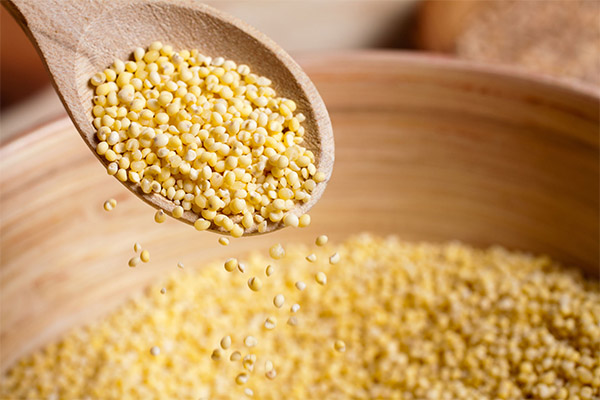
For women
Millet is not in vain considered "women's porridge". This product has a beneficial effect on the health of the fairer sex of mankind. It contains minerals that are necessary for the normal functioning of the reproductive system and the production of hormones in the right concentration.
Porridge is rich in magnesium, and this component has a beneficial effect on the health of the nervous system and hormonal background. It helps to cope with stresses, emotional and psychological stress, to survive the menopause with ease, eliminates PMS.
For men
Most of all men will be able to appreciate the benefits of millet porridge. This product is a source of energy, strength and active ingredients that support the male body. Mineral compounds and organic acids take care of reproductive health. They increase libido, stimulate cell regeneration, thereby protecting the body from pathological processes and premature aging.
Glutamic acid, which is contained in high concentrations in millet seeds, is especially valuable for men who lead an active life. This natural ingredient is often used in sports pharmacology in the creation of dietary supplements for maintaining good form and rapid recovery after intensive training. Antioxidants help to cope with oxidative stress, protect members of the stronger sex from cancer and benign tumors, and support defense mechanisms.
When pregnant
Gynaecologists in different countries recommend that women include porridge in their diet, especially millet, because it has a beneficial effect on the health of the mother and child. It is desirable to use this product on a regular basis. With it you can do without vitamin supplements, if there are no threats and pathologies. That is why it is so important to eat millet during pregnancy:
- Antioxidants protect the embryo from intrauterine abnormalities and the woman from disease and inflammation.
- B vitamins and minerals contribute to the healthy development of the nervous system.
- Plant protein is used by the body for growth and development of the child.
- Potassium and sodium in the porridge help maintain a healthy water-salt balance.
- Micronutrients support cardiovascular health.
- Tocopherol supports the female body and participates in the development of internal organs of the fetus.
- The presence of fiber helps maintain a balance of microflora, due to which a woman's digestion is normalized and the immune system strengthens.
During pregnancy, you must be especially careful to select the products, study their composition and nutritional value. Millet can be a component of the diet, but it is important not to abuse, as cereal porridge is quite caloric and can provoke the recruitment of excess weight. Also, an excess of this product in the diet can lead to constipation, which is also extremely undesirable for pregnant women.
When breastfeeding
Millet when breastfeeding - a source of minerals, vitamins, healthy fats and other components that are badly needed by the body of the mother and baby. This cereal contains substances that together give a number of benefits:
- eliminate mineral and vitamin deficiencies;
- normalize digestion;
- strengthen the immune system;
- stimulate the development of the brain and nervous system in general;
- beneficial effects on the cardiovascular system and hematopoiesis.
Millet is an excellent way to cope with diarrhea. It should definitely be included in the diet after taking antibiotics, and use it as a source of minerals and vitamins to maintain the health of the child and his mother.
For kids
Children just need to be given millet, because it is an indispensable product for their growth and healthy development. To keep your child from getting sick too often, you can even use this cereal every other day, especially during the season of colds and viral infections. Porridge can be present in the diet of children from a very young age, from about 8-10 months. But it should be introduced gradually. At first give your baby 1 teaspoon of porridge, diluting it with fruit puree, and watch for a day to see how it reacts. If the body does not react to the product, you can gradually increase the portion of porridge and come to a full volume.
Children can be given porridge of millet. This will not be a problem, because its taste is often liked even by the most fastidious kids. For those who do not really like porridge, you can cook it in milk with sugar and fruit, supplemented with nuts. That's why millet is so useful for children:
- gives energy;
- promotes fast and intensive growth;
- Supports the health of the digestive system;
- normalizes the microflora;
- provides a normal metabolism;
- prevents anemia;
- saturates the body with vitamins and minerals.
Millet is an ideal breakfast for schoolchildren. This product is slowly digested and thus gives energy for 3-4 hours. Porridge contains a whole mineral and vitamin complex that stimulates brain function, protects vision, helps children to concentrate, improves memory and attention.
For weight loss
Millet helps to cope with excess weight, and without grueling diets and starvation. If you use this groats in the diet correctly, you can quickly cleanse the intestines, remove toxins from the body, establish a healthy metabolism. There are at least 5 reasons why thinners need to eat millet at least 2 times a week:
- Millet is rich in fiber and plant fibers, so it takes a lot of energy for the body to digest it.
- The product is rich in vitamins, which boost the metabolic process.
- Cereal contains substances that help the liver cells process large amounts of fat, which is important in the fight against excess weight.
- Cereals enrich the body with fatty acids, which take part in biochemical reactions of fat breakdown.
- The product gives a prolonged feeling of satiety, helps to get rid of the habit of overeating and not feeling hunger.
There are even millet diets designed for those who want to lose extra pounds. Reviews of such food systems are contradictory. In any case, it is not recommended to use unbalanced diets for weight loss. It is better to make a full-fledged diet, taking into account the balance of the BZU and supplement it with physical activity.
Millet in medicine
Nutritionists recommend that all healthy people diversify their diet with porridges made of millet. The product has a powerful preventive and therapeutic potential, so it can be used as a component of the diet for various diseases.
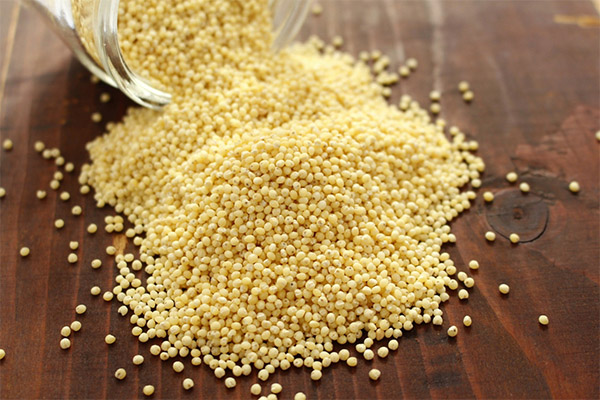
In Diabetes Mellitus
Millet can be one of the products that are used in therapeutic diets for type II diabetes. This cereal normalizes metabolic processes, removes toxic substances from the body, prevents the development of ketosis and an increase in blood sugar levels. Millet helps to minimize the negative effects of diabetes, improves blood supply and tissue nutrition, prevents obesity and the development of atherosclerosis.
This product is rich in protein, the main source of energy that is used by the body in diabetes. The problem is that in this diagnosis, carbohydrates are poorly absorbed and animal protein leads to severe oxidation of the body and poor health. Plant-based protein is not harmful to health.
In pancreatitis.
Millet is able to activate the regeneration of the organs, even with a long, sluggish inflammatory process. This is exactly what you need in chronic pancreatitis. In the acute stage, this cereal is completely excluded from the diet, prescribing a dietary diet. In chronic pancreatitis, millet should be eaten at least 2-3 times a week. You can cook it with low-fat milk or water. But there is a particularly useful recipe.
In a saucepan with thick walls pour ½ cup of groats and add 2 cups of cold water. Bring the porridge to a boil over low heat, then simmer for 30 minutes. You can add salt and a small amount of vegetable oil, but it is best to supplement the porridge with mashed baked pumpkin and a small amount of honey. In such a combination, the products effectively cope with the inflammatory process, relieve spasms, normalize the production of enzymes.
With gastritis
Millet with gastritis can be used as well as other types of cereals, but you can not eat it too often and in large quantities. To eliminate inflammation, you can even use remedies prepared on the basis of this cereal crop. There are three recipes.
- Pour 2 liters of boiling water ½ cup of cereal and soak under a lid in a saucepan for 2-3 hours. Strain, drink 150 ml at the occurrence of pain and heartburn.
- Mix rye, oat and millet flakes taken in equal parts, steep a handful with a glass of boiled goat milk and eat such a breakfast for 14 days. This will help to relieve inflammation and restore the mucous membrane of the stomach.
- Pour a tablespoon of cereal in 250 ml of purified or cold boiled water, soak for an hour, then grind the grains in a blender and mortar and drink the milk on an empty stomach. Repeat the procedure for 20 days.
With gastritis, it is desirable to combine millet with vegetable fats. You can add hemp, linseed, sesame, olive oil to the porridge. These additions will make the main product even more useful and speed up the recovery of the stomach.
For the intestines
The benefits of millet for the health and normal functioning of the intestines are invaluable. It is one of the grains capable of producing the following healing effects:
- improve digestion of food;
- normalize microflora;
- Cleanse the body of toxins and impurities;
- eliminate inflammation in the intestines and eliminate mucus;
- Restore the mucosa in peptic ulcer disease;
- protect against harmful substances and free radicals.
Wheat must be eaten after taking antibiotics, which kill the beneficial microflora. This porridge is rich in dietary fiber, which helps to restore colonies of beneficial bacteria that produce B vitamins for the body, which are responsible for the immune response. Millet for intestinal health for preventive purposes should be consumed at least 2 times a week.
For constipation
If there is constipation, you can cope with it with ordinary millet, without using medication. If you prepare the porridge correctly, it can quickly restore intestinal peristalsis. For the product to benefit from constipation, it is necessary to use it with the following recommendations.
- It is necessary to make a slightly undercooked, crumbly porridge, it has a laxative effect.
- Be sure to season the finished product with vegetable oil and do not use animal fats.
- It is worth cooking millet with vegetables, which are rich in vegetable fiber. This component contributes to more effective digestion, and also has a pronounced laxative effect and enhances the effect of the main product.
- In order to cure constipation, you can use milk of millet. To do this, you need to rinse it thoroughly, pour 2 tablespoons with a cup of steep boiling water, soak for 30 minutes and mash. Drink on an empty stomach 100 ml for 3 days, store in the refrigerator.
The advantage of millet in the treatment of constipation is that it eliminates directly the cause of intestinal dysfunction and has virtually no side effects. If there is a tendency to this problem, you can permanently use this product in the diet.
For gout
Millet contains active alkaline components that react with salts of uric acid, i.e. eliminate the main cause of gout. In addition, groats have hepatoprotective effect and stimulate the kidneys to excrete toxic substances. Therefore, the product has a complex effect on the body and normalizes the metabolism. Due to this it is possible to solve the problem more quickly and to restore normal health.
For gout, you can use unrefined millet, that is, millet. It should be infused in a thermos. If it is difficult to get the seeds, you can use cooked groats. It is necessary to put a tablespoon of the product in a liter thermos, pour boiling water and soak for 2 hours, and then drink it warm 4-5 times a day for 100 ml. With the help of millet, you can speed up the recovery, but you can not abandon the main therapy.
For the liver
Millet is a powerful natural antioxidant and hepatoprotector. The same properties are inherent in refined grains, that is, millet groats. It can be used in the menu for liver diseases. This product restores the functioning of the liver, accelerates the regeneration of the cells of this organ, removes toxins, thus facilitating the task of the main filter of the body. For treatment, you need to cook millet on water, take small portions every day, preferably for breakfast. To enhance the effect, it is necessary to supplement the porridge with such products:
- pumpkin;
- beet;
- citrus fruits;
- vegetable oil;
- garlic.
You can prepare a powerful medicine for the liver. Take a tablespoon of grits, pour a cup of milk and add a teaspoon of turmeric powder. Divide into 2 times and drink in the morning and evening. The course of treatment is two weeks.
When hemorrhoids.
Millet should be added as an additional component to the main diet in the treatment of hemorrhoids. This is not just porridge, it is a medicine that copes with the disease many times faster. This product has a mild laxative effect, so it helps to get rid of anal fissures and stop the increase in hemorrhoids. It also contains substances that stabilize the walls of blood vessels and normalize blood viscosity. Due to this, porridge helps to reduce the size of lumps over time or eliminate them completely, if the main treatment is chosen correctly.
In cholecystitis
Millet porridge can be used in a therapeutic diet for cholecystitis. If this product is properly prepared, it will become a valuable medicine for the gallbladder. Cereal acts directly on the affected organ and produces such healing effects:
- Helps prevent the formation of stones.
- Tones the walls of the gallbladder, restores its motor function.
- Stimulates the production of bile and makes it more concentrated, due to which the enzymatic fluid better performs its function in digestion.
- Eliminates inflammation, prevents the formation of adhesions.
- Normalizes appetite, eliminates bitterness in the mouth and a feeling of nausea.
To treat cholecystitis in the acute stage, you can use small portions of millet boiled in water. It should be well-cooked, so you can take even flakes or add twice as much liquid. It is also forbidden to use animal fats as a seasoning for cholelithiasis. It is best to add vegetable sunflower or olive oil to the porridge, which will further enhance the therapeutic effect of the product.
Hypothyroidism
Thyroid disease requires long-term treatment with a specific diet. Without the right diet, it is not possible to get fast results even with the right therapy. With hypothyroidism need to diversify the menu with products that are rich in fiber, contain vegetable protein and contribute to the absorption of iodine. Millet is exactly the kind of cereal that is needed for this disease.
This cereal can be used in the diet often, it is desirable to prepare a meal from it 2-3 times a week. With regular use, you can normalize the functioning of the endocrine system, improve your well-being and increase the effectiveness of basic therapy. The main thing is to make sure that there are no contraindications, so as not to worsen the condition of the body trying to help the thyroid gland.
In cystitis.
With inflammation of the bladder, it is worth reconsidering your diet and enrich it with safe products that contribute to a rapid recovery of the body. Millet can be used not only as a component of a therapeutic diet, but also as an herbal medicine. From it you can prepare an infusion, decoction or suspension and take it as an addition to the main course of treatment. This product is used to improve well-being and accelerate recovery. There are three popular recipes.
- To prepare an infusion, take a three-liter jar and pour one-third of the millet, which washed in advance. Add to the top cold boiled or purified water. Close and leave the jar overnight in a dark place, and in the morning, strain and take the liquid 100 ml 3-4 times a day.
- Put 2 tablespoons of washed cereal in a pot, pour a liter of cold water and bring to a boil. Turn off the stove, cover the broth and wait until it cools slightly (to a temperature where it can be drunk). Strain, squeeze the raw material and take 100 ml 4 times a day. Course duration - 5-7 days.
- For suspension, prepare 100 g of grits and 300 ml of water. Pour boiling water over the product, grind until a homogeneous mass (milk of a light cream color), drink 1 tablespoon 4-5 times a day.
For those who often suffer from cystitis, this porridge can be a real salvation. It can be used in chronic diseases of the genitourinary system as an aid. The components that make up the product, inhibit the reproduction of pathogenic bacteria and support the functioning of the urinary system.
Millet in cosmetology
Millet and even raw millet seeds are widely used in cosmetology as a skin and hair care product. The rich composition of the product makes it effective in skin care. Of course, it is best to use unpeeled grain, it is more useful, but you can make skin care products from cereals.
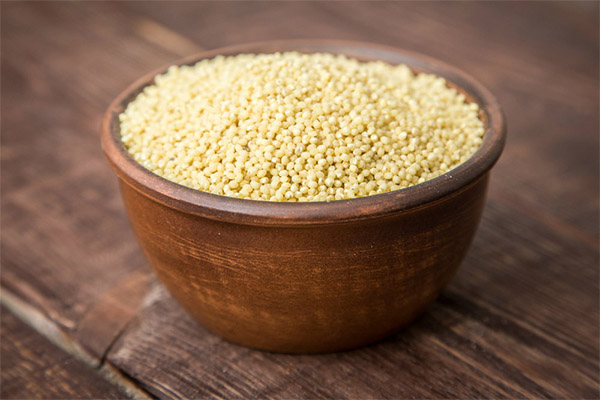
- Grind millet into flour, make a tablespoon of 30 ml of boiled hot milk and stir it. Apply the mush to cleansed skin, when it cools a little and wash off after 15 minutes. Repeat twice a week. This mask stimulates cell regeneration, improves complexion, nourishes and moisturizes the skin.
- Prepare a tablespoon of grits flour, brew it with 100 ml of strong black tea, add a pinch of red pepper and stir. Rub into the scalp and leave for 10-15 minutes, then rinse. This mask powerfully stimulates hair growth, improves its nutrition and appearance.
- Take a teaspoon of millet flour, a tablespoon of cream. Also add to the mixture a pinch of grated ginger root and a teaspoon of ground coffee. Mix everything and use for exfoliating treatments in the shower as a body scrub.
Millet improves elasticity and elasticity of the skin, making it smooth and velvety. A decoction of raw millet can also be used for hair. You need to boil 2 tablespoons of seeds in 2 liters of water, insist until it cools and use to rinse your hair.
Harm and contraindications
In some cases, millet can be harmful to the human body. This porridge can cause damage to health in case of food allergies to this product. Even if the person is completely healthy and does not have hypersensitivity, you should not abuse the product. In case of inordinate consumption of millet, the following undesirable effects may appear:
- bloating, flatulence;
- digestive disorders;
- pain and cramps;
- nausea;
- constipation.
The optimal amount of millet in a person's diet is 1-3 servings per week, you should not abuse the product. Nutrition should be not only balanced, but also varied, so that all the needs of the body are covered. Millet is not a substitute for other grains. Also, this product can be harmful for such problems:
- acute thyroid disease;
- Acute exacerbations of pancreatitis;
- Gastric and intestinal ulcers.
With chronic constipation it is not recommended to use this product too often in the diet. Also you should not abuse millet in acute liver and kidney diseases.
Can be allergic to millet
As any other product, millet can cause allergic reactions in people who are hypersensitive to the organic components that comprise it. Hypersensitivity can manifest itself by symptoms such as:
- A feeling of discomfort in the stomach;
- nausea;
- diarrhea;
- rash;
- itching;
- poor appetite;
- intoxication.
An allergic reaction to this product develops quite rarely, but the risk still exists. Therefore, if the following symptoms were noticed after consuming porridge, it is worth to give it up and consult a doctor. The most effective way to find out if a person is allergic to millet is to take tests.
How to choose and store
Going shopping, you need to know how to choose the right millet, so that it turns into a tasty and useful porridge. Recommendations for this groats are slightly different from the rules for choosing other cereals. For millet to be fresh and healthy, you need to adhere to the following recommendations.
- The first thing to pay attention to the date of manufacture and storage. On cereals it is usually written 1.5-2 years, but it is better to buy the product from the last harvest. Stale product will be bitter and have an unpleasant smell.
- It is better to take millet, which is sold in an individual package. It contains more valuable substances. Rare groats quickly lose their valuable properties, some of the substances are oxidized in the air.
- It is important to pay attention to what color the product. Bright yellow porridge will be sweet, it boils faster and turns out soft. Dark yellow varieties have a darker yellow hue, which turn out crumbly. Light grits are good for making salty porridge.
- It is necessary to look at the grains themselves, they should be the same size, whole, with a matte surface.
- It is worth inspecting the packaging, it should be undamaged. The fact is that moths and other insects that like to eat cereals quickly become infested in millet. Even in the whole bag can be infested, the larvae of which got there at the stage of production.
It is also worthwhile to decide before buying, for what purposes you need millet. Depending on the dishes in which it will be used, you can select the appropriate variety. Today in grocery stores there are three types of groats.
- Dranets - whole millet, which is suitable for the preparation of delicious side dishes and crumbly porridge. All grains are perfectly round, do not boil and retain their integrity.
- Crushed millet - for those who do not have time to cook porridge for an hour. This kind is suitable for quick breakfasts, boiled and has a more delicate taste.
- Flakes - flattened grains that are very fast to cook, some types can simply be boiled with boiling water or hot milk. A great product for a quick snack, you can take it with you to work so you can eat healthy food at lunchtime instead of sandwiches.
It is better to store millet in a closed container, so it does not become infested with gnats and bugs. Immediately it is worth pouring the groats into a glass or tin jar, you can take cloth bags, but this is the most unreliable option (they can also be infested with moths). The duration of storage of the product depends on the date of production. If the packaging was sent to the trash, it is better to look in advance at the date that is indicated on it, and to sign the container in which the millet was poured.
How to cook millet: recipes
Millet is very easy to cook. With this groats there will not be any problems, if you adhere to the technology of cooking and observe the proportions. The product is suitable as a base for side dishes, sweet porridge and other dishes. There are several basic recipes for cooking millet, which can be used as a base.
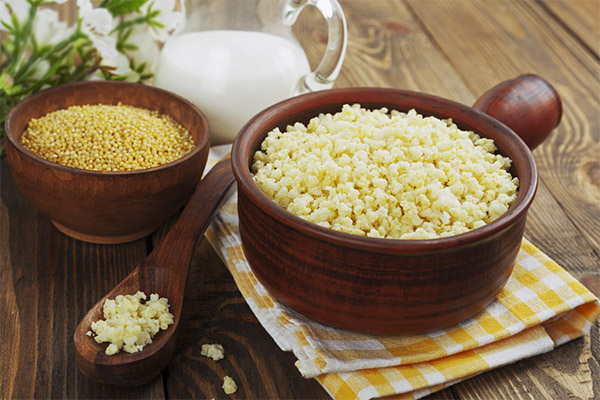
With milk
Before cooking, it is important to wash the prepared cereal. This is a prerequisite, because it is unknown how it was stored before packaging. Grain warehouses are often quite dusty, so the finished product is bound to contain unhealthy impurities. Rinsed cereal first pour cold water, in a ratio of 1:2, that is, 2 cups of liquid per glass of grain. When the porridge boils, reduce the heat and simmer for 15 minutes, and then add milk and cook until the grains become soft.
Before completing the cooking, you can add such products to the milk millet to make it tastier:
- apricots;
- candied fruits;
- prunes;
- diced apples (not sour, otherwise the milk will curdle);
- raisins;
- vanillin;
- ground cinnamon;
- ginger powder.
Before serving, be sure to put a piece of butter in the plate. You can supplement this recipe with any other ingredients. For example, lay fresh berries or pieces of fruit marmalade on the prepared porridge, fill it with honey, pour chocolate topping or caramel syrup.
With water
Millet is most often boiled in water, as this method of cooking is the easiest and fastest. In addition, cooked porridge can be made both sweet and salty. It all depends on tastes and personal preferences. To cook millet in water, you need to read the recommendations on the package, they may be different for each type of cereal.
In order to cook whole grain, you need to use water in a ratio of 1:3. That is, for 1 cup of groats take 3 cups of water. Millet first rinse under cold water, you can soak it for 15-20 minutes, then it will cook faster, and the less time of heat treatment, the more useful substances are retained in the product. Therefore, this method of cooking is considered the most appropriate if the porridge is used for therapeutic purposes as a component of the diet.
You can throw the washed cereal in boiling water, and then reduce the heat and cook until tender. It is better to add salt immediately, if it is planned to use the porridge as a side dish. If the millet will be a sweet dish, sugar should be thrown at the very end of cooking. Average boiling time - 40 minutes, but for different varieties and varieties of cereals may differ.
In a multicooker
Cooking millet porridge in a multicooker is the easiest. It is convenient, you can turn on the device in the morning, throw all the ingredients into the bowl and go about your business, and when everyone wakes up for breakfast, the millet will already be ready. Of course, there are many ways to cook this product in the multicooker, but there is also a basic recipe that you can take as a basis. Millet with milk and cream is beneficial to the body, it is a great energy boost for the first half of the day. If you supplement the porridge with useful additives - nuts, candied fruits, dried fruits or fresh berries, you can increase its nutritional value and replenish the body's need for vitamins and minerals.
To prepare it you need the following ingredients:
- 1 cup of millet;
- 3 cups of milk;
- 1,5 cups of water;
- 100 ml of cream;
- A pinch of salt, just to reveal the flavors of the product;
- sugar to taste, at your discretion;
- vanillin;
- 50 g of butter or margarine.
Before proceeding to cooking, you need to prepare the products. Cereal rinse with cold water. Then put all the ingredients in a bowl and mix them (except for butter, it is better to add it to the finished dish in the bowl or on a plate). After that, select the appropriate mode (many models of multicookers have a function "Cooking porridge"), set the timer for an hour. After the signal for the end of cooking, add butter, and turn on the mode "Maintain temperature" so that the millet is finally boiled.
How to cook millet in the oven
Millet can be made into a very tasty side dish or breakfast in the oven. This porridge turns out especially tasty if it is toasted for a long time on a minimum temperature. You can cook millet with vegetables, meat, make a sweet version with dried fruits and raisins.
Recipe for porridge with meat
It is necessary to prepare a special container that is not afraid of high temperature. Standard clay pots for baking, heat-resistant glass forms will do. If the container, which is available, does not have a lid, you can use foil.
Ingredients:
- 1 cup grits;
- 3 cups of meat broth;
- 500 grams of pork or beef;
- 1 teaspoon salt;
- 1 onion;
- 1 carrot;
- bay leaves;
- allspice;
- vegetable little.
First you need to fry meat in a pan in oil, cut into small pieces, with onions and carrots. Then transfer it to a mold or a baking pot. Add washed groats, spices and salt, mix and pour the broth over it. Put the pot in a heated to 160 degrees oven and cook for 1 hour.
Sweet milk porridge
This dish is sure to please children, moreover, it will be very useful for them. In the process of cooking in the oven manages to preserve the maximum useful substances in the products, which means that the porridge will be a source of valuable vitamins and minerals.
Ingredients:
- 2/3 cup of cereal;
- 2,5 cup milk;
- 50 ml of cream;
- vanillin;
- 2 tablespoons sugar;
- 1 tablespoon of butter.
It is necessary to wash the millet and drain the water. At the bottom of the pot pour the melted butter, add the cream and sugar. Pour the groats and stir, add milk and vanillin. Cook in the oven at 160 degrees for 50-60 minutes. Before serving, decorate with dried fruit or fresh berries. You can add candied fruits, apricots, prunes or raisins during cooking.
Can we give millet to animals
Millet porridge is often used by pet owners as a component of the diet. It is mixed with liquid feed or cooked in meat broth and served to animals. But this is not always correct. For cats, this product can be dangerous. The digestive system of these animals is not adapted to digest such food. Because of the binding effect of regular consumption of millet porridge, cats can develop constipation, disrupting the functioning of the entire gastrointestinal tract. Instead of millet for cats, it is better to use buckwheat and rice - these types of cereals are easily digested by the digestive system of animals and do no harm.
Dogs can be given millet, but only after one year, preferably from one and a half years. You can use this product to make porridges with meat or fish products that are allowed in the pets' diet. It is important to look at the menu recommendations for the particular breed and make sure that the pet tolerates this food normally. In any case, this product is not suitable for the daily diet, but can be used periodically to diversify the menu.
Interesting facts about millet
Millet has always been highly valued as a raw material for the production of nutritious groats. But despite the fact that this product has been used by people since ancient times, there are many facts that are little known to mankind.
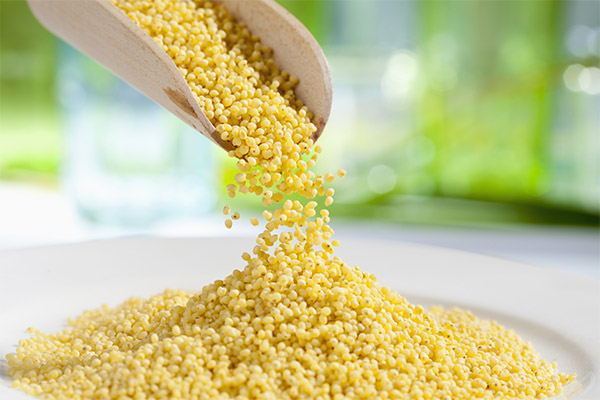
- Millet is used to produce alcohol in Nepal. It is used to make a fragrant alcoholic drink called Tongba.
- This cereal is the best antidepressant. It contains a full range of vitamins and minerals that promote the production of serotonin and dopamine, the hormones responsible for feelings of joy and happiness and satisfaction with life.
- Millet is one of the few plant foods that are rich in alkaline proteins. It does not oxidize body cells, on the contrary, it restores Ph to normal levels.
- For a long time, millet was called rice, not millet. When Peter I brought it to Russia, many perceived it as just a type of grain.
- Millet is often used in sports nutrition as a source of vegetable proteins, valuable amino acids, vitamins and minerals.
Millet is not just cereals, it is a natural therapeutic agent, the basis for skin-care cosmetics, as well as a good feed for animals. If you use this product correctly, it will bring tremendous benefits to the body!
«Important: All information on this site is provided for informational purposes only. for informational purposes only. Please consult with your health care professional before using any of the recommendations. specialist before using any of the recommendations. Neither the editors nor the authors shall be liable for any possible harm caused by materials."

